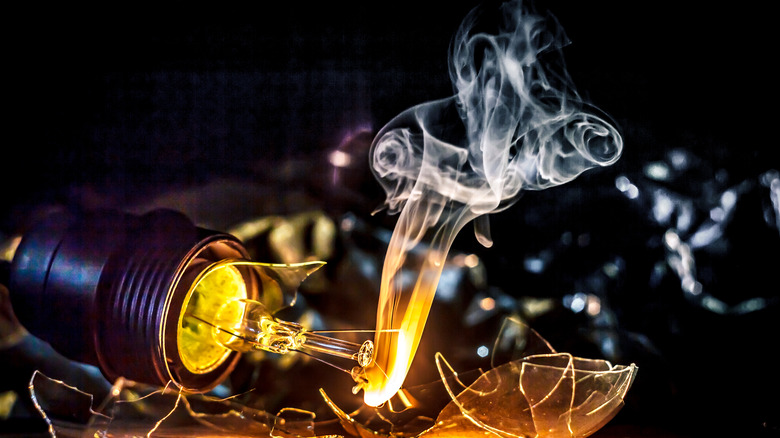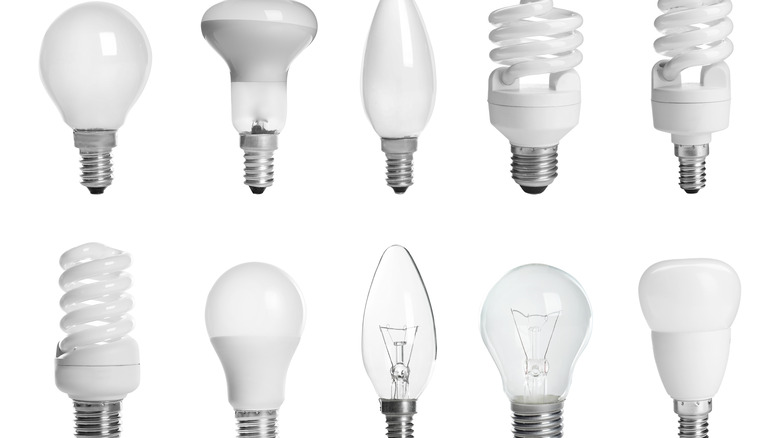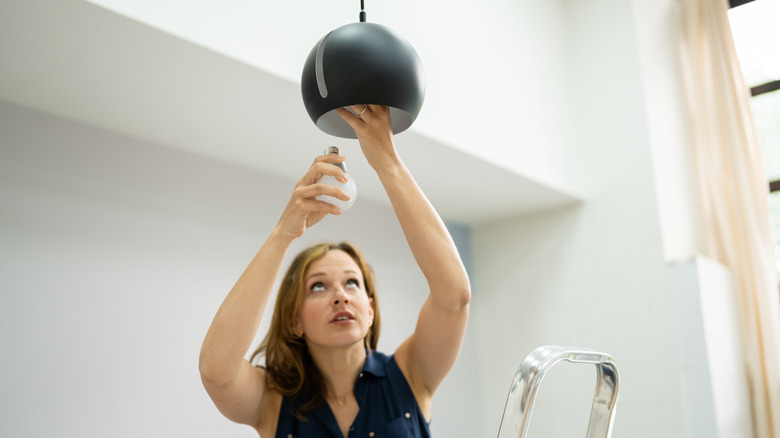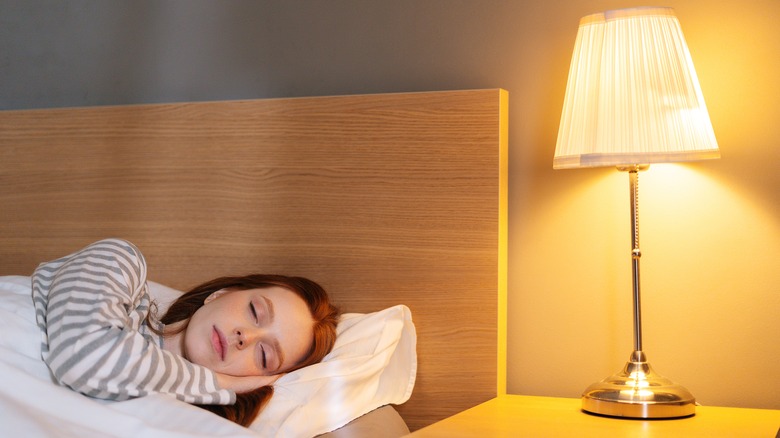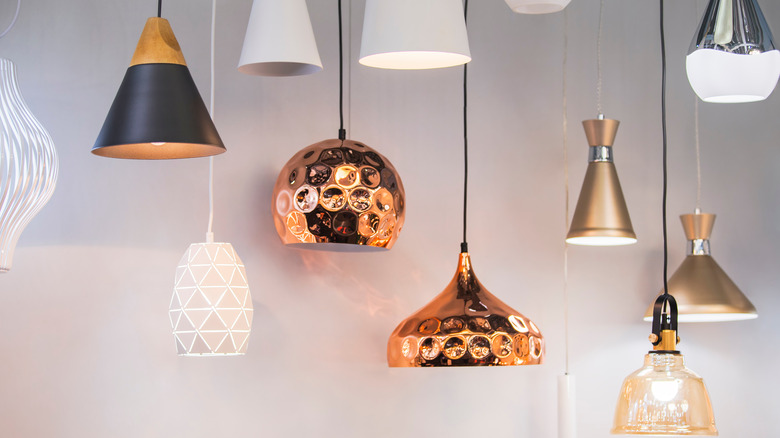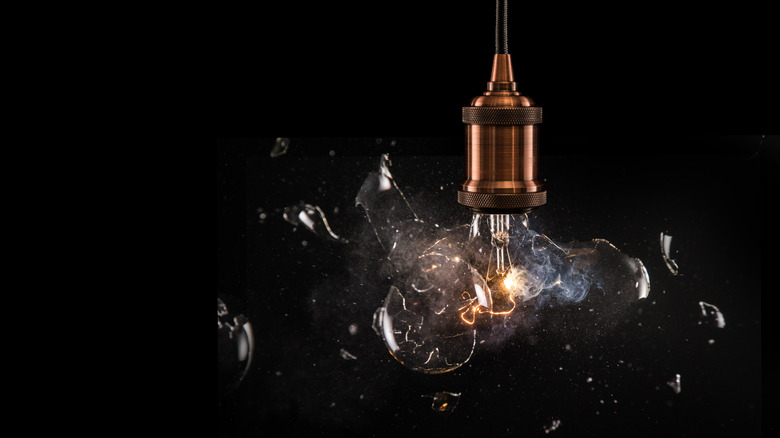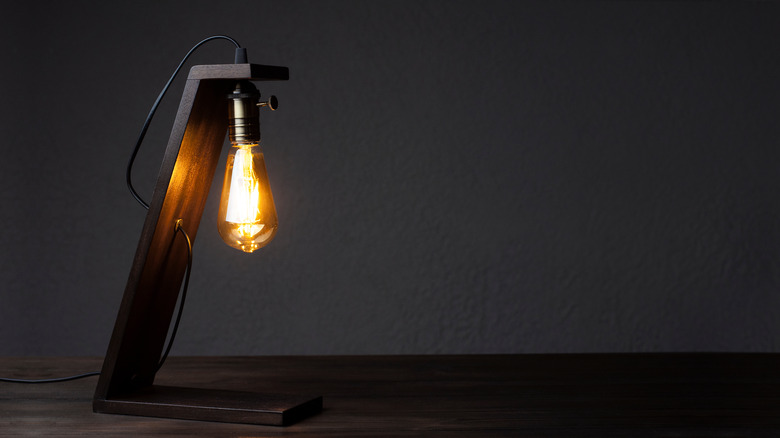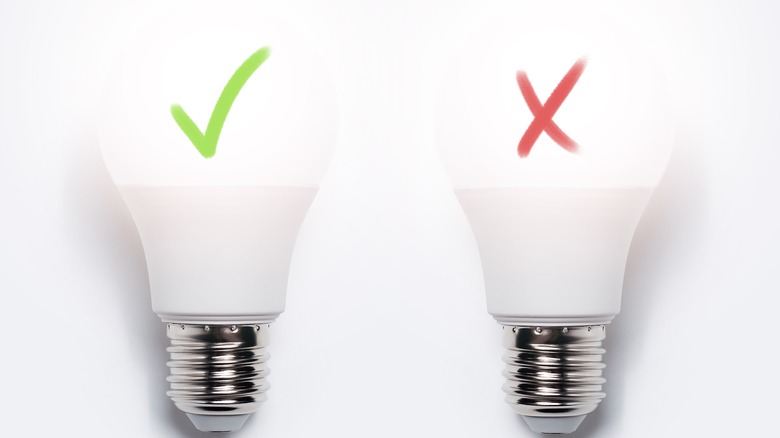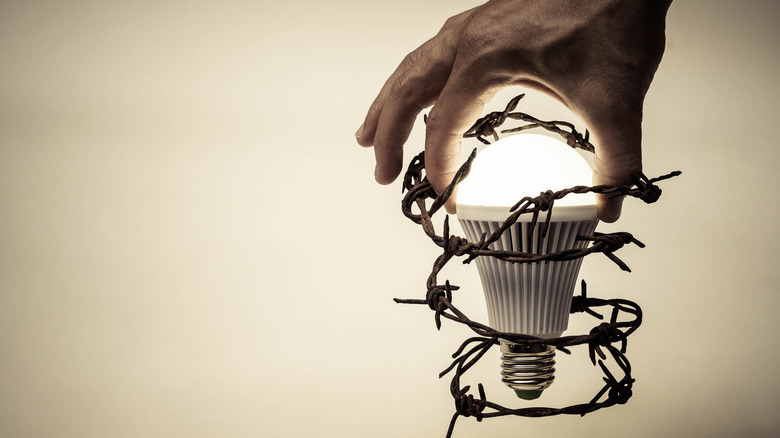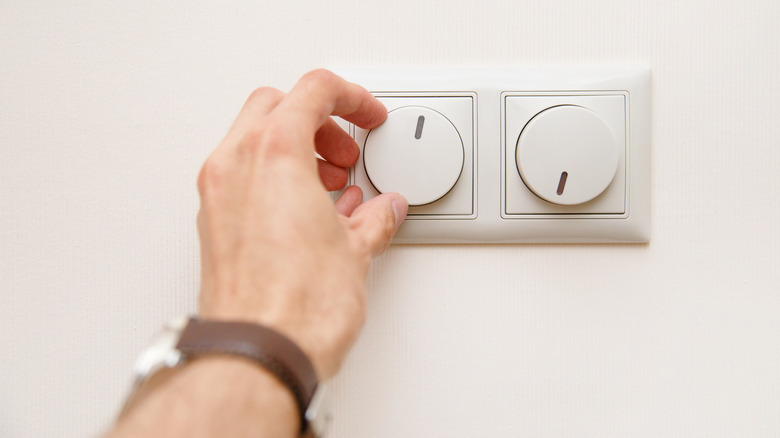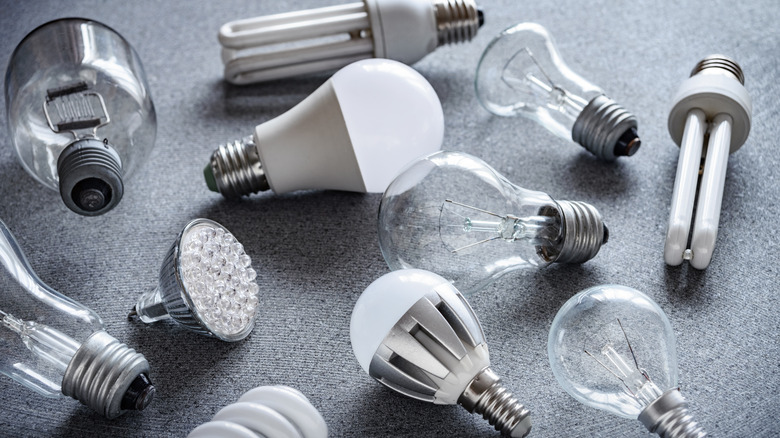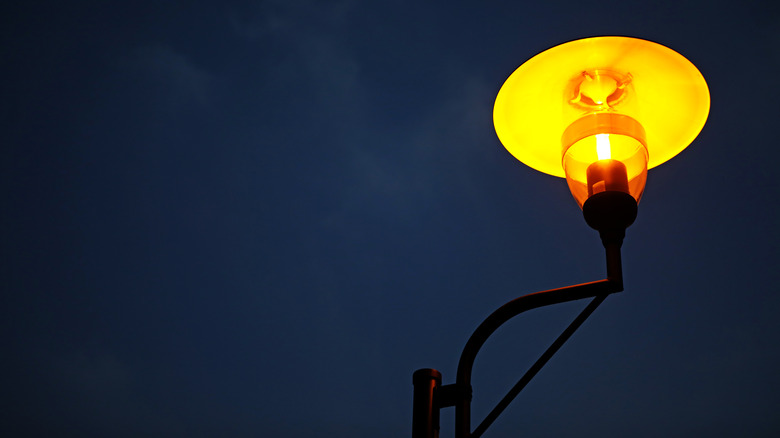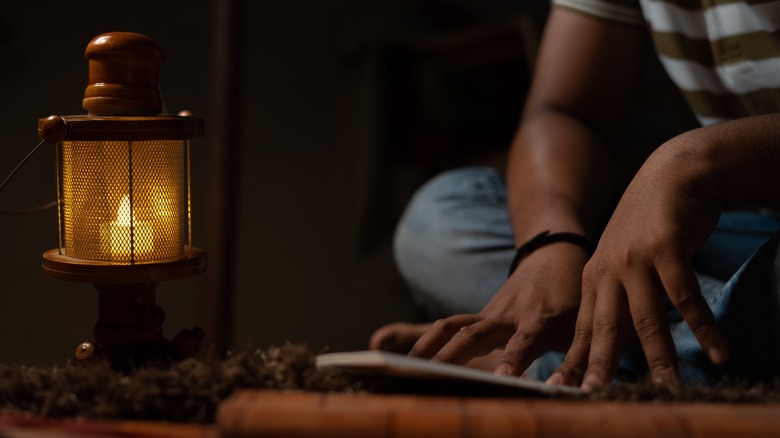Mistakes Everyone Makes When Buying Light Bulbs
They take up multiple aisles in home improvement stores. In fact, there are entire stores dedicated to them, and entire professions built around installing them. There are probably dozens in your home no bigger than an ant, and there's a 13-foot, eight-ton one in Edison, NJ (via Atlas Obscura). But for some reason, when we think of light bulbs what usually springs to mind is the standard E26 incandescent bulb. There's obviously a lot more to it than that.
Light bulbs vary wildly in form factor, aesthetic qualities, type and efficiency of power use, materials, safety, and suitability for particular purposes. There's a huge range of options for something that you usually don't think about very much if everything's going right. And if everything's not going right, you're sitting around (or working or driving or cooking) in the dark. Home Stratosphere has charts of 56 bulb types (that actually show at least 90) grouped by shape, base, and size. Wayfair lets you shop by type, wattage, lumens (brightness), color, shape, base, and location (damp, wet, or dry).
Let's take a look at these factors and see what you might be doing wrong when you're shopping for bulbs.
The various types of light bulbs
For most of their history, "light bulbs" meant incandescent glass bulbs, and we know what they were like: hot, fragile, and bright. They were so power-hungry that power bills were commonly called "light bills," and if you paid your household's light bill you were keenly aware that they were expensive to operate. This was because they were pretty bad at converting electricity to light, and converted a lot of power to heat instead. Then along came more efficient fluorescent bulbs with their poor color rendering and danger of shattering, then absurdly expensive light-emitting diodes (LEDs). These — incandescent, compact fluorescent (CFL), and LED bulbs — make up the bulk of bulbs found in homes.
LEDs are still the most expensive option, though they've dropped in price dramatically in recent years. Green Living Ideas and Cheapism ran similar calculations to determine the break-even point of bulb ownership, and found that LEDs are more cost-effective than incandescent bulbs by 17 months, and also pass CFLs within the second year of ownership. The average cost of owning and using an LED bulb was $31.43 over 10 years, while CFLs cost $52.31 and incandescents cost $236.07 over the same period.
Mistake: Buying cheap incandescent or LED bulbs
Because of environmental concerns and this discrepancy in cost, light bulb innovation and regulation have been underpinned by concerns about energy efficiency. When LED bulbs were expensive enough to be impractical for most households, the public believed that bulb cost offset most of the energy savings. Many people are still in the habit of buying cheaper incandescent bulbs for this reason, but in reality the justification disappeared rapidly so that now saving large amounts of power (and reducing power bills) is real for most of us. The new Department of Energy regulations for light bulbs, which make stringent demands on incandescent bulb efficiency, will further support this trend (via The New York Times). These rules are expected to save Americans $3 billion annually on power bills, with a corresponding benefit in reduced carbon dioxide emissions.
But cheap LED bulbs have problems of their own. According to Frye Electric, some cheap brands of LED are poorly designed and overheat, so they burn out early, while better heatsinks in better bulbs eliminate this issue. So check the reviews; bulbs with a reputation for burning out easily might not give you the savings you're looking for.
Mistake: Choosing the wrong color temperature
Bulbs don't just produce light and heat, they produce light of a particular color. While new RGB or RGBW smart bulbs can produce any color adjacent to the rainbow, all standard bulbs have two color qualities that can make a bulb perfect (or perfectly terrible) for a particular room: color temperature and color rendering.
Color temperature is a measure of how the light looks when we look directly at it, and is quantified in degrees Kelvin (K). Light around 2700K is described as "warm," while 3700K light is a cooler bright white and 5700K is said to simulate blue-white sunlight, according to ProLampSales. Warmer, yellow-tinted light is usually preferred in common home living areas such as dining rooms, living rooms, and bedrooms. You'll find cooler, bluish light in office settings and closets or bathrooms, where the apparent clarity is more valued.
A light's color rendering index (CRI), expresses on a 1-100 scale how accurately light displays the color of an object. This is important if you want to see objects, finishes, and people as they are, undistorted by inaccurate lighting (via Elemental LED). Flexfire LEDs notes that high CRI values can be important for certain commercial operations in which accurate color is a must, like photography or grocery sales.
Mistake: Buying bulbs that are too dim or too bright
In most lighting situations, one thing we care a lot about is brightness, by which we usually mean the number of lumens a bulb or fixture emits. This is somewhat related to the wattage of a bulb, which has energy consumption and safety implications, but more energy-efficient bulbs blur this relationship somewhat, says Popular Science.
Different rooms in a home usually require different levels of brightness (and therefore bulbs with different lumen ratings). Kitchens and other workspaces might call for higher-lumen bulbs, while bedrooms and living rooms require less. One way to roughly calculate lumen requirements is to add 20 lumens per square foot of floor space, replacing that with 30 lumens for tables and 50 lumens for workspaces with task lighting, such as counters and desks (via Creative Lighting). This will at least give you a starting point for determining how to light a particular area or room. But because the effect of having multiple bulbs confounds such calculations, you'll need to adjust quite a bit based on your direct experience with this starting point.
Mistake: Buying the wrong wattage bulb for your fixture, and other safety considerations
Wattage has implications for brightness, and even more impact on potential safety issues. High-wattage light bulbs left on for long periods (such as vacations) can result in fires, particularly when used in fixtures of questionable quality, says Adjusters International, a large insurance adjustment firm. And even high-quality lamps have wattage limits, usually shown on a sticker on the device, so choose bulbs appropriate to this rating.
Using bulbs with a higher wattage than their fixture is called overlamping, and Electrical Experts says this causes fixtures to overheat and fail in various ways. This is a particular problem with enclosed fixtures, which exacerbates the overheating problem. Such overheating concerns aren't usually applicable to LED bulbs, which operate at much cooler temperatures.
There are other safety considerations when handling light bulbs. The high temperatures of incandescent bulbs can cause burns. And the thin glass that makes up incandescent and CFL bulbs can be hazardous if broken, according to Intelect Lighting. CFL bulbs contain toxic mercury, so handle these with care and dispose of them according to manufacturer instructions. The National Capital Poison Center has some fairly scary advice for dealing with broken CFLs, such as temporarily evacuating the room and throwing away any contaminated fabric.
Mistake: Having the wrong fixtures to begin with
Sometimes the problem with your light bulb isn't the bulb at all, but where you're sticking it. Most of us have an unsophisticated understanding of lighting techniques, but a solid intuitive handle on what is good versus poor lighting. To get the most out of your lighting experience, the trick is to turn that intuition into the right fixtures in the right places... and the right bulbs to go into them.
For example, renewable energy company Arcadia discusses the value of mixing up lighting sources, saying that we too often rely on a single light source for a room or, in fact, our entire home. Arcadia recommends mixing light types such as overhead, accent, and task lighting. Y Lighting recommends under-cabinet lighting in kitchens, which provides both task lighting and pleasing ambient light for the whole room, but warns against accenting the wrong areas or accenting them too brightly.
Both Y Lighting and Realtor.com compare rooms with too many recessed lights with airport runways, and for good reason. The solution: again, mixing up the lighting to provide enough light without overwhelming the entire room.
Mistake: Buying a bulb that doesn't fit
All those fixtures would be complicated enough without the further complication of bulb form factors and base standards. These can have inscrutable names, inconsistent implementations, and sometimes impractical qualities of all sorts. You don't want to go buying a candelabra bulb when you need a mini candelabra bulb. And you certainly don't want to attempt to screw a standard E26 bulb into a mogul base (E29) socket... and if you do try, don't let go! Although the bases are visually similar, the mogul is much larger, according to Home Stratosphere.
If you think "mogul" is a peculiar name for a bulb base, hang on to your hats. Both E39 and E40 bases are called "mogul," while EX39s are called "extended mogul." Both E26s and E27s are "medium," and E17 bulbs are "intermediate." And corn lamps appear to be named after the bulb's similarity to corn, while COB lights describe a particular LED mounting method, and it will surprise no one that there are corn COB lights.
Mistake: Getting voltage and AC/DC wrong
It's not a common problem for the average homeowner, but if you venture far from the standard set of household bulbs you will eventually encounter bulbs built for DC power systems (landscape lighting, low-voltage systems, automotive applications, and many others). These systems convert the alternating current of the power grid back to direct current (DC), the format required for most devices.
Using the wrong current type or voltage certainly won't work properly, and often the result of trying is the instant destruction of your bulb. It's not difficult to mistake a DC bulb for an AC bulb. Home Depot stocks 60w equivalent A19 E26 (descriptors for overall shape and base) bulbs that are indistinguishable from the usual 110v ac bulbs. One major difference is that if you screw this bulb into your normal lamp and turn it on, it will blow instantly (see the reviews for such tales of woe).
Keep track of both the voltage and the AC/DC designation, because some bulbs will work with both 12V AC and 12V DC, but will self-destruct at 110v AC.
There's an ongoing IEEE project designed to determine if running households on DC power only is feasible, mostly for rural and undeveloped areas for whom grid infrastructure isn't practical. So far results are inconclusive but promising, according to California Polytechnic State University, meaning this issue might soon become even more vexing.
Mistake: Turning light bulbs on yourself
Smart light bulbs fill a variety of roles in the home, and it's about more than just turning lights on and off. According to LED Dynamics, "human-centric lighting" can be described as tunable white lighting (in which you can control the color temperature of your lights). These lights can be made to mesh with our natural Circadian rhythms to support alertness, control weight, and improve sleep, immune response, athletic performance, etc.
Smart bulb timing, brightness, and color can be controlled and integrated into complex cause-effect chains (if it's morning, turn on the coffee maker, set the lights to a bluish color temperature, turn on lo-fi hip hop, and dump a bucket of water on the kids). There are security benefits (turn on exterior lights whenever a person's presence is sensed) and safety improvements (not risking fire by leaving lights on, or turning on stair tread lights when someone is on the steps).
Smart bulbs can typically be controlled with smart assistants like Amazon Alexa, home automation systems like Home Assistant, specialized automation software like IFTTT, or apps on your smartphone.
Mistake: Buying disposable LED fixtures
Some fixtures, including both cheap and more expensive devices, include integrated LEDs that can't be replaced when the fixture is damaged or the lighting wears out. According to LED Lighting Info, tightly integrating LEDs into fixtures leads to better-designed and cheaper products, but ones that are disposable since it's impractical or unreasonable to have them professionally serviced versus simply replacing a bulb.
You might think you'd never buy such a thing, but chances are you already have. For example, many common overhead kitchen lights look like the fluorescent fixtures of old, but are actually LED light strips affixed to the inside of the housing, and these strips can't be replaced by the average homeowner. Unless you're prepared to have a technician visit your home to repair a $50 light fixture, odds are you're going to end up trashing the old one and replacing it with... you guessed it... another disposable fixture.
This is completely rational, from most points of view. You might still choose to buy such a fixture; there's little that can replace a high bay light made up of a zillion tiny LEDs in a garage. But usually you'll want to avoid light fixtures in which the bulbs can't be replaced.
Mistake: Using the wrong bulb for your dimmer
The topic of dimmers is confusing to almost everyone, and this isn't helped by the fact that many dimmers are superficially interchangeable. The wrong dimmer can cause flickering, drop-out of a particular light range, jerky dimming progressions, and more unfun stuff.
Dimmer switches are important to making your home lighting more than a simple all-or-nothing affair, according to Arcadia. But dimming LEDs gets tricky. First of all, the bulb itself must be dimmable; non-dimmable bulbs will flicker erratically when dimmed (via LED Lighting Info). Second, you need a compatible dimmer. Dimmable LEDs will sometimes work on old incandescent dimmers, but they won't get as dim as they can with LED dimmers. If your LED bulbs don't meet the minimum wattage requirement of the dimmer, it won't work at all, per The A&D World. Your best bet is to change to a compatible dimmer.
A note about flicker: dimmed LEDs will generally flicker (turn on and off, which is how brightness is controlled) at a rate high enough to be safe for people, but Architect Magazine says some individuals can be affected if LEDs are dimmed using a low frequency. Frequencies between 3 and 70 hertz can be dangerous for susceptible individuals.
Mistake: Buying the wrong bulb for your application
Special-purpose bulbs of all sorts exist, and you'll be familiar with at least a few of them. You'll have seen landscape lighting, whether or not you're familiar with the 20W Equivalent T4 G8 Bi-Pin Base LED. There are appliance bulbs, grow lights, rough service bulbs, and many others. Sometimes they're physically interchangeable with other bulbs that aren't suitable, so it pays to know exactly which you need.
Anything that doesn't use a standard medium E26 base can probably be thought of as "special purpose," but the base doesn't tell the whole story. As an example: Regardless of base size, you can't use most regular bulbs in such appliances as ovens, microwaves, refrigerators, freezers, and clothes dryers, according to Lighting Adviser. A standard LED might survive for a while in a fridge or freezer, but an appliance bulb will last longer. And a standard LED won't survive a preheating oven.
There are a huge number of specialty bulbs, and they aren't always LEDs. Work lights might require a special double-ended bulb. Standard LED bulbs can interfere with garage door openers, so those require a special bulb (via Downing's Hardware). There's security lighting, accent lighting, cabinet lights, three-way lamp bulbs, and tons more.
The outliers: Halogen, metal halide, sodium vapor, etc.
There are a few fairly common light types we're not covering here, and it's worthwhile to be familiar enough with them to know that you don't usually want to buy them. In particular, these include high-intensity discharge (HID) bulbs, which use an electric arc rather than a filament to produce light. HID bulbs require special fixtures, and they can be expensive and potentially hazardous, so it's best to use them only where they serve best, in places such as industrial settings and large outdoor areas. HID bulbs in general tend to be very energy efficient. Where are you most likely to need HID bulbs around the home? Street lights (which are usually replaced by someone else) and your car's headlamps (which aren't).
While you might occasionally see halogen lights in your security lights or garage work lights, they aren't appropriate for most home uses. According to Superior Lighting, halogen bulbs have some issues. They are very hot and filled with compressed gas, so they often require a transparent shield in case they shatter. They can't be touched by bare hands because it will cause premature failure of the bulb, and they don't last long even with proper handling.
Alternatives to traditional electric lighting
There are alternatives to common light bulbs, depending on your needs. LED strips and panels are often used in place of standard bulbs and fixtures. These are only different from LED bulbs in form, as the LEDs themselves are simply light-emitting diodes like all the others. But they have unique and sometimes desirable characteristics. Light strips fit in places other bulbs don't, such as under stair treads and behind televisions. Panel lights are large, bright, durable rectangles of light that can replace fluorescent ceiling fixtures and enhance architectural design, according to HomElectrical.
In some cases, you don't want traditional electric lighting at all (for example, off-grid and emergency preparedness applications). Your best options in this case include lamps powered by gas, oil, kerosene, propane or paraffin, per That Yurt. But these can come with safety tradeoffs. Unattended candles, for example, occasionally cause house fires (via Adjusters International). But the low power consumption of LEDs in low voltage, battery- and solar-powered installations is making candles, oil lamps, and the like less attractive.
